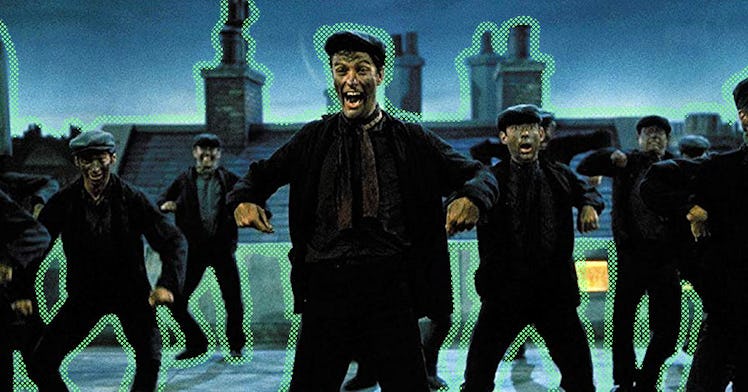Is Mary Poppins Racist? Depends On Which Poppins You Mean
Book Poppins was racist. But is movie Poppins?

As the Governor of Virginia — Ralph Northam — has been outed as a person who horrifyingly dabbled in blackface in high school, the historical tendrils of racism have maybe outed another public figure; a magical nanny who flies on an umbrella. Shockingly, the one thing Mary Poppins shares in common with Northam is past accusations of blackface. So, what’s the deal? Is Mary Poppins a racist?
Here’s one thing that we know for sure: Mary Poppins does get black soot on her face in the original 1964 Mary Poppins. Does that make the character a racist because the soot is connected to a white person donning blackface? In the film — and its latest sequel, Mary Poppins Returns — the answer seems unclear. But in the books, the answer is probably yes.
On January 28, Daniel Pollack-Pelzner penned an op-ed for the New York Times titled “‘Mary Poppins,’ and a Nanny’s Shameful Flirting With Blackface.” Note the use of the word flirting. Pollack-Pelzner isn’t saying that the character is racist. Nor is he saying Emily Blunt or Julie Andrews are racist. In the Op-ed he’s simply pointing out that people say and do racist things in original P.L. Travers Mary Poppins books, and, though the 1964 classic film might not be overtly racist, it carries with it the racist baggage of the novels, specifically, the chimney soot on the faces of white people. In fact, in the classic Disney film version, Admiral Boom does say “We’re being attacked by Hottentots!” which is a derogatory and antiqued slur for black Africans. This moment is in the film. This is undeniable. Did I have any idea what it meant as a child? Did you? Does anyone remember this?
The answer for many is probably “no.” But, Pollack-Pelzner’s point is well taken. Even if the original Mary Poppins doesn’t scan as racist now, there are racist undertones because of its source material, and because of this specific line. Pollack-Pelzner also points out that in the new 2018 film, a song called “The Cover is Not the Book,” does include passing references to hyacinth macaw, a racist caricature from another of the Travers Poppins books.
Since the publication of this piece, many have rushed to defend Mary Poppins and have insinuated that Pollack-Pelzner has gone too far. But, the idea that old Disney stories may be linked to racism — or discrimination — is hardly news. In fact, if you want to get real, when it comes to sexism and racism, Disney films only recently became more progressive. The Little Mermaid is about regressive and sexist as you can imagine (a woman losing her voice becomes attractive to a man?) while older favorites like Peter Pan freely use deplorable racist words like “the red man.”
Disney might struggle with this kind of thing publicly, but the people who struggle with it privately are parents. Intellectually, denying Pollack-Pelzner’s impeccable research would be insane. He’s clearly right. There is some connection between the two Poppins films and the racist caricatures of the book. But again, for parents who have been grappling with the Disney catalog already, this news is useful, but also a little frustrating. Should we sit down with our kids and connect the dots for them in order to point out that, yes, this scene in Mary Poppins — to use Pollack-Pelzner’s word — “flirts” with racism? Maybe we should.
But, most parents — of all races — are a little too tired to worry about Mary Poppins, when there are much bigger and more obvious offenders in children’s entertainment and Disney in specific. For example, in the wake of the Nick Sandmann controversy, Peter Pan again springs to mind. Could Nick Sandmann have been primed to be racist by watching the original Peter Pan? It seems like a reasonable assumption since the racism in Peter Pan is so damn obvious. But, is the 1964 Mary Poppins or the new Mary Poppins Returns damaging our kids, in the same, overtly obvious way that Peter Pan might? It’s tough to say yes, but in the face of Pollack-Pelzner’s argument, you can’t rule it out either. Invisible racism is still racism, right?
I think the racist crows in Dumbo are a good argument for the movie being banned. But the soot on the face of the chimney sweeps in Mary Poppins? I don’t know. That doesn’t seem like the problem. Instead, the problem seems to be that Admiral Boom should not be screaming a racial epithet — outdated or not — in a beloved children’s “classic.” Which means Disney could actually do something about that. Take the line out.
If George Lucas can alter Star Wars, and Steven Spielberg can remove the guns from the hands of characters in E.T. (yeah, remember that?) then Disney can certainly remove this line from Poppins. And as far as Mary Poppins Returns using another racist allusion to the books? Well, the movie isn’t on Blu-ray yet, so Disney could do something about that, too.
The point is this. When it comes to kid’s entertainment, parents want solutions, not endless debate. And in the case of Mary Poppins, the solution seems to be simple: Don’t let your kids read the books unless you want to deal with explaining what outdated slurs actually mean. Watch the 1964 classic, and if your kid asks about the soot, you say it’s soot. And then, hope and pray Disney releases a new version that removes Admiral Boom all together.
This article was originally published on